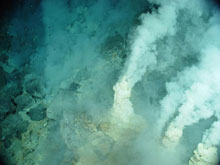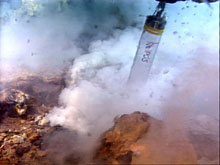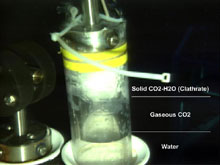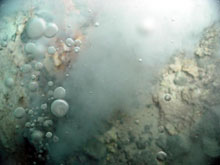
White chimneys at Champagne Vent site, NW Eifuku volcano. The chimneys are ~20 cm (8 in) across and ~50 cm (20 in) high, venting fluids at 103ºC (217ºF). Notice the droplets in the upper left portion of the image. Click image for larger view
Champagne at 1 Mile Deep, Anyone? The Vent Site at NW Eifuku Volcano
April 10, 2004
John Lupton
Oceanographer
Pacific Marine Environmental Laboratory (PMEL), NOAA
Dave Butterfield
Chemical Oceanographer
JISAO Program, University of Washington
NOAA Vents Program, PMEL
During our first dive at NW Eifuku volcano, a remarkable hydrothermal site was discovered near the summit, 1,650 meters (more than 1 mi) below sea level. Small white chimneys vented cloudy white fluid at the site. ![]()
![]() Surprisingly, droplets composed of some sort of fluid were rising out of the sediment around the chimneys. (mp4, 5.1 MB) Droplets have been seen before in hydrothermal systems, but never in such great abundance. It’s obvious why
Surprisingly, droplets composed of some sort of fluid were rising out of the sediment around the chimneys. (mp4, 5.1 MB) Droplets have been seen before in hydrothermal systems, but never in such great abundance. It’s obvious why ![]()
![]() the site was named “Champagne” (mp4, 4.4 MB). The droplets were slightly opaque, only barely buoyant, and sticky, adhering to surfaces on the ROPOS ROV. The droplets also differed from typical gas droplets in that they had little tendency to fuse into larger droplets, even when touching each other.
the site was named “Champagne” (mp4, 4.4 MB). The droplets were slightly opaque, only barely buoyant, and sticky, adhering to surfaces on the ROPOS ROV. The droplets also differed from typical gas droplets in that they had little tendency to fuse into larger droplets, even when touching each other.

ROPOS capturing droplets from the sea floor at Champagne Vent. The plastic tube is 45 cm (18 in) long. Click image for larger view.
The fluid pouring from the white chimney orifices was measured at 103ºC (217ºF), considerably above the surrounding water temperature of 2ºC (36ºF). Fluid samples were collected in special titanium bottles for gas analysis, and in plastic containers for chemical analysis. We discovered that the fluids venting from the chimneys at the Champagne site are super-charged with dissolved gases! These fluids want to expand over 50 times in volume as the ROV ascends to the surface, because the confining weight of seawater pressure is removed.
Although we have not completed any detailed analysis of the composition of the dissolved gases in the chimney fluids, we conclude that it is most likely predominantly carbon dioxide. Furthermore, the fluid droplets exiting from the sea floor around the chimneys are most likely composed of liquid carbon dioxide. The opaque coating on the droplets is likely a thin layer of carbon dioxide hydrate forming on the surface (a solid carbon dioxide material composed of water and carbon dioxide). These hydrates, or clathrates as they are also called, form only at ocean depths below 350 m (1,150 ft) when high concentrations of carbon dioxide are present in seawater. The Champagne site is one of only three sites known to be venting droplets of liquid carbon dioxide and forming natural carbon dioxide clathrates. Furthermore, the carbon dioxide concentration in the Champagne vent fluids is, as far as we know, the highest ever recorded for oceanic hydrothermal fluids.

The experiment to observe the change in phase of the droplets collected at Champagne Vent. What began as solid carbon dioxide hydrate (clathrate) and water on the sea floor is, at this depth (300 m, 900 ft), converting to gaseous carbon dioxide and liquid water due to the decrease in pressure as the submersible ascends. Click image for larger view and more details.
As a follow-up experiment on the second dive at NW Eifuku, we captured some of the mysterious droplets in an inverted plastic tube. While still on the sea floor (1,650 m, 5,400 ft), some fluffy white material (probably clathrate) formed in the plastic tube along with the droplets. When the ascending sub reached a depth of ~400 m (1,300 ft), the contents of the plastic tube began to bubble vigorously. This is roughly the depth at which we would expect both liquid carbon dioxide and the clathrate to convert to gaseous carbon dioxide. By the time ROPOS reached a depth of 50 m (165 ft), all of the solid white material was gone and the plastic tube contained only clear gas and seawater. Our observations seem to confirm that the droplets collected at the vent field were indeed liquid carbon dioxide. Analysis of the samples collected in the gas-tight bottle will verify this theory.
Sign up for the Ocean Explorer E-mail Update List.




























